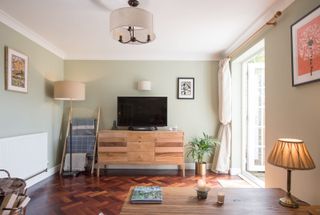How much electricity does a TV use? Plus how to calculate your TV's running costs
Some households have one in each room, so calculating a TV's energy usage can be worthwhile when trying to save the pennies. Here's our guide, including how to calculate costs

How much electricity does a TV use? The last thing we want to think about as we settle down on the sofa for the evening is how much watching a bit of television might cost us.
But with the cost-of-living-crisis and recent energy price hikes, working out how much electricity your TV uses is a smart move as part of host of energy saving tips.
It is important to understand if different types of screens or television manufacturers will cost you more. And, at a time when many people are cancelling their Netflix subscriptions, we want to understand what terrestrial and other forms of television are costing us.
The energy price cap is currently set at 34p per kWh hour, and we’ve used it to answer these questions for this article. Being armed with the right information should hopefully let you enjoy your favourite shows with peace of mind.
How much electricity does a TV use?
The average 48 to 50-inch television in the UK costs 45p to run a week.
This calculation from Which? is based on four hours of watching time per day and 20 hours on standby. Of course, the amount of electricity your TV uses depends on the type of screen and its size.
The picture on a television with a 4K resolution like this £329 Samsung TV from John Lewis might be great, but it uses more power than a 1080p HD TV, like this £199 one. LCD screens are the most expensive option, while QLED screens are typically the cheapest.
The model of TV you choose has an impact, too. Let’s break it down:
| Average cost per year | 40-43 inch | 48-50 inch | 55-58 inch | 65 inch |
|---|---|---|---|---|
| LG | £25.74 | £24.10 | £28.34 | £35.80 |
| Panasonic | £14.48 | £19.49 | £25.16 | £30.81 |
| Phillips | £20.99 | £22.71 | £24.94 | £30.70 |
| Samsung | £22.80 | £25.51 | £27.21 | £32.03 |
How to calculate your TV's energy usage
To calculate how much your TV's energy usage is, you need to find out its wattage. Some TVs might have two settings, one for high dynamic range and one for standard range. The higher definition range is likely to be a higher wattage.
TVs will usually list their energy consumption in annual kWh. This is typically based on1000 hours of usage (for example, this Samsung TV uses an annual 55kWh for 1000 hours of use in the year). You will need to work this back to find out its cost to run per hour.
The calculation for this is: annual kWh x electricity cost, then divided by 1000 hours of usage to get the hourly usage.
So, if electricity costs 0.34 per kWh with our Samsung TV example above, the calculation is: 55x0.34 = 18.7, 18.7/1000 =0.0187
It'll cost 1.9p an hour to run the Samsung TV in our example.
How much energy does a TV use on standby?
The power consumption of modern televisions ranges from 0.5W to 3W on standby. The power consumption of your specific TV is often listed in the product specifications of your model, so it's worth checking your fine print.
Standby uses a small amount of electricity. But as your television can be left on standby for hours each day, the costs can mount up.
Most new TVs use less than 1W. This means the cost of leaving a television on standby is likely to cost you pennies per day.
According to research by EcoCostSavings, leaving a television on standby costs £12 in electricity every year. That's about 3.2p per day.
The above calculation was conducted before the increase in energy prices, so you can expect the cost of leaving a television on standby in November 2022 to be 80% higher.

How can I reduce energy use from my TV?
If you want to save money, you could invest in a smaller television. As with most things, the smaller your device the less electricity it uses.
A 40-inch Panasonic costs £14.48 a year to run, for example, according to Which?
There are things you can do to cut costs when watching TV, such as turning the brightness down slightly and turning it off at the plug rather than leaving it on standby when not in use.
It sounds obvious, but make sure your TV is switched off when nobody is watching. A Uswitch survey of British households found that 42% leave the TV on for a pet.
Get the Homebuilding & Renovating Newsletter
Bring your dream home to life with expert advice, how to guides and design inspiration. Sign up for our newsletter and get two free tickets to a Homebuilding & Renovating Show near you.
Matilda Battersby has been gradually repairing and renovating an Edwardian maisonette flat on and off for nearly a decade. She has written about homes and property regularly for the Evening Standard and Zoopla for many years. She is also a freelance journalist and editor for a number of different newspapers, magazines, brands and agencies.
